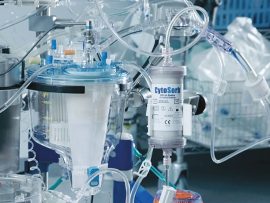Abstract Acute kidney injury is a common complication following cardiac surgery (CSA-AKI). Serum creatinine levels require a minimum of 24–48 h to indicate renal injury. Nevertheless, early diagnosis remains critical..
Read MoreAbstract Objectives Heart donation after circulatory death was recently reintroduced in the United States with hopes of increasing donor heart availability. We examined its national use and outcomes. Methods The..
Read MoreAbstract Optimal oxygen management during pediatric cardiopulmonary bypass (CPB) is unknown. We previously demonstrated an increase in cortical mitochondrial reactive oxygen species and decreased mitochondrial function after CPB using hyperoxic..
Read MoreAbstract Objective: To describe characteristics associated with survival for pediatric patients with an oncologic diagnosis or hematopoietic cell transplant (HCT) supported with extracorporeal membrane oxygenation (ECMO). Design: Multicenter, retrospective study...
Read MoreAbstract Introduction Simulation-based learning has become an essential element in entry-level perfusion education. While the use of simulation has been demonstrated to improve patient outcomes, few institutions possess the budgetary..
Read MoreAbstract Despite technological advances in left ventricular assist device (LVAD) technology, which have made survival competitive with heart transplantation at 2 years, right ventricular failure (RVF), with an incidence of..
Read MoreAbstract The threshold for packed red blood cell (pRBC) transfusion has been an important focus in the management of critically ill patients since the publication of randomized control trials (RCTs)..
Read MoreAbstract Blood-contact medical devices are indispensable for clinical interventions, yet their susceptibility to thrombosis and bacterial infections poses substantial risks to treatment efficacy and patient well-being. This study introduces a..
Read MoreAbstract The clinical tolerance of extracorporeal membrane oxygenation (ECMO) membrane changes in acute respiratory distress syndrome (ARDS) patients under veno-venous ECMO (VV-ECMO) has not been reported. The aim of this..
Read MoreAbstract OBJECTIVES: To determine the actual cost and drivers of the cost of an extracorporeal cardiopulmonary resuscitation (E-CPR) care cycle. PERSPECTIVE: A time-driven activity-based costing study conducted from a healthcare..
Read MoreAbstract The concept of left ventricular unloading has its foundation in heart physiology. In fact, the left ventricular mechanics and energetics represent the cornerstone of this approach. The novel sophisticated..
Read MoreAbstract Rationale and Objectives To evaluate the quality and value of contrast-enhanced (CE) chest- and abdominal computed tomography (CT) and CT angiography in neonates, children, and adults undergoing extracorporeal membrane..
Read MoreAbstract OBJECTIVE. Extracorporeal membrane oxygenation (ECMO) is increasingly widely used in pediatric respiratory failure. Despite playing a key part in patient management during ECMO, the role of radiology is not widely..
Read MoreAbstract Background: Extracorporeal membrane oxygenation (ECMO) is a complex procedure affecting both the risk of thrombosis and bleeding. High-quality data to personalize anticoagulation management in ECMO are lacking, resulting in..
Read MorePROCESS SUMMARY & APPLICATION FORM Overview The International Perfusionist Equivalency Assessment (IPEA) provides a pathway for internationally trained Perfusionists to become certified in Canada. This process ensures that candidates meet..
Read MoreAbstract During the coronavirus 2019 (COVID-19) pandemic, children suffered severe lung injury resulting in acute respiratory distress syndrome requiring support with extracorporeal membrane oxygenation (ECMO). In this case series, we..
Read MoreAbstract Background Rhabdomyolysis describes a syndrome characterized by muscle necrosis and the subsequent release of creatine kinase and myoglobin into the circulation. Myoglobin elimination with extracorporeal hemoadsorption has been shown..
Read MoreAbstract Introduction Pump-controlled retrograde trial off (PCRTO) is described as an effective weaning strategy for veno-arterial extracorporeal membrane oxygenation (ECMO) in the guidelines. Contrastingly, there is no established weaning strategy..
Read MoreAbstract Cell-free hemoglobin (CFH) is used to detect hemolysis and was recently suggested to trigger acute lung injury. However, its role has not been elucidated in severe acute respiratory distress..
Read MoreAbstract Drug treatments for coronavirus disease 2019 (COVID-19) dramatically improve patient outcomes, and although extracorporeal membrane oxygenation (ECMO) has significant use in these patients, it is unknown whether ECMO affects..
Read MoreAbstract The endothelial glycocalyx (EGC) is a layer of proteoglycans (associated with glycosaminoglycans) and glycoproteins, which adsorbs plasma proteins on the luminal surface of endothelial cells. Its main function is..
Read MoreAbstract Comprehensive optimization of rotodynamic blood pumps (RBPs) requires the consideration of three partially conflicting objectives: size, hemocompatibility, and motor efficiency. Optimizing these individual objectives independently, the potential of multiobjective..
Read MoreAbstract OBJECTIVES The multifactorial dynamic perfusion index was recently introduced as a predictor of cardiac surgery-associated acute kidney injury. The multifactorial dynamic perfusion index was developed based on retrospective data..
Read MoreAbstract Purpose Veno-venous extracorporeal membrane oxygenation (VV-ECMO) is an integral part of the management algorithm of patients with severe respiratory failure refractory to evidence-based conventional treatments. Right ventricular injury (RVI)..
Read MoreAbstract Introduction Exogenous haptoglobin administration may enhance plasma-free hemoglobin (pfHb) clearance during hemolysis, and reduce its end-organ damage: we sought to systematically review and summarize available evidence on the use..
Read MoreAbstract OBJECTIVES Activated clotting time (ACT) is commonly used to monitor anticoagulation during cardiac surgeries. Final ACT values may be essential to predict postoperative bleeding and transfusions, although ideal values..
Read MoreAbstract Objective To analyze if the implementation of a multidisciplinary extracorporeal cardiopulmonary resuscitation (ECPR) program in a tertiary hospital in Spain is feasible and could yield survival outcomes similar to..
Read MoreAbstract Cardiopulmonary bypass (CPB) can alter pharmacokinetic (PK) parameters and the drug may adsorb to the CPB device, altering exposure. Cefazolin is a beta-lactam antibiotic used for antimicrobial prophylaxis during..
Read More


















